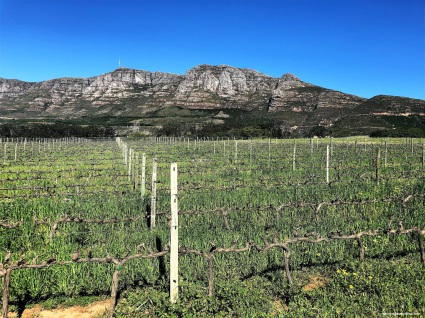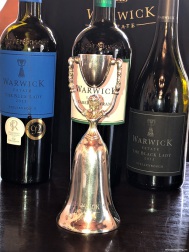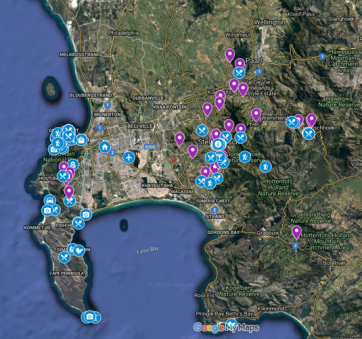South Africa Wine Country Travel Guide
If you only have a short time to visit Constantia, Stellenbosch and Franschhoek, take these tips
Every year when we are planning our next big vacation adventure, I have two major criteria; one is to explore a new wine region, and the other is to visit a country that my husband has never been to. That becomes more and more challenging each year. Last year we chose to visit South Africa. If you are considering a visit to South Africa, I am sure you will be planning on exploring the coastal cities and perhaps a lovely safari. But please, be sure to reserve some time to visit South Africa’s wine county.
There are three major regions close to Cape Town, that are more than worthy of day trips. The closest is just 20 minutes southeast is Constantia, which is the oldest wine-producing region in Z.A. (this is the local abbreviation for South Africa). The second is Stellenbosch, which is about 30 minutes east and the third is Franschhoek which is about one hour east of Cape Town. As I always recommend, write to the wineries in which you are interested, well-in-advance of your trip. This will ensure that the winery is available and staffed for your visit.
You can certainly self-drive the wine routes, but there is truly no reason to exert the effort and take on the risk of wine tasting and driving. I will cover transportation options in each region, but I can personally recommend our Cape Town Car Hire driver; Jean Pierre Rukundo. He handled our Cape Town Township tour, Cape Peninsula tour, Airport pick up, Constantia tour and Stellenbosch transfer. His contact info is in the resources section at the end of this article.
Constantia-
Not only is Constantia the oldest wine region in Z.A., it is one of the oldest in the southern hemisphere. This is an old farming community which is now one of the wealthiest suburbs of Cape Town. It is located between Cape Town and the Cape Peninsula. To be efficient with your time, you may combine a visit to the southern tip of the Cape with a visit to Constantia. Founded in 1685 by Dutch Colonial Governor Simon Van der Stel, who was assigned to study the soils of the region by the Dutch government. When it was time for his land grant, he choose the best soils in the center of the Cape Peninsula. Following his death the estate was subdivided into the major estates you will see to this day. You may visit a some of the wineries as part of the Hop-on Hop-off City Sightseeing bus route.
Recommended wineries
Klein (small) Constantia – Try to schedule a tasting and a tour of the vineyards. A most unique aspect of this estate is the large number of aggressive baboons that terrorize the vineyards. The staff is known to battle more than 100 baboons a day. This estate is known world-wide for the sweet elixir of a dessert wine known as “Vin de Constance”. This wine, made from Muscat de Frontignan, was a favorite of Napolean Bonaparte. The estate is currently planted to 70% Sauvignon Blanc and I highly recommend that you include some in your wine tasting. The wines are readily available in the U.S.
Groot (great or large) Constantia- This is the estate where the original Cape Dutch Manor house has been restored. There is a wine museum and cultural history museum. A self-guided audio tour is provided. The estate is now known for its “Grand Constance” dessert wine and its red wines, it is also a great place to sample the sparkling wine of the region known as Method Cap Classique.
Beau Constantia- This boutique wine farm has a beautiful situation at the top of the hill with a view of False Bay. It is also home to one of the several Chef’s Warehouse brand restaurant, so I highly recommend coordinating your visit to include the Chef’s tasting menu. These wines are not distributed in the U.S., but the tasting experience is worth the visit. Each employee is an ambassador of the winery and will conduct a personal visit with your group.
Steenburg Farm (stone mountain)- This is a complete resort complex containing a winery, hotel, two restaurants and a golf course. If you would like to immerse yourself in wine country, check them out.
Stellenbosch-
The name means “city of oaks” and is the second oldest settlement in the province. Currently it is an enchanting university town that is commendable for a few nights stay. You will have the benefit of nice restaurants and shopping within walking distance of your hotel. The natural beauty of the surrounding wine country is dramatic with mountains and valleys on all sides. To enjoy a guided walking tour of the city, stop by the information kiosk and book a tour with Stellenbosch on Foot. Getting around the dozens of wineries within 10 miles of Stellenbosch is so convenient and easy with Uber. They are plentiful and usually close-by when you are ready to go to your next winery.
One of my favorite features of visiting wineries in Stellenbosch is the sheer number of wineries with excellent, gourmet restaurants attached to them. It is really difficult to narrow down the selections for lunch each day. Reservations are highly recommended. Many will also offer picnic boxes to enjoy on the grounds or take away. A good resource for information regarding events, hotels, restaurants, wine routes, maps, wineries and other attractions is Stellenbosch Wine Routes.
Recommended wineries
Warwick Estate- At the time of our visit ownership of the estate had just changed from the Ratcliffe family to an American tech company. But I have been assured that the same friendly, welcoming experience is still to be had by visitors. However, I don’t know if the “Big 5” wine estate “safari” is still being offered. Be sure to inquire, as it is a wonderful way of touring the estate and hearing the stories of the varietals related to the big 5 safari animals. Our guide, Elton, was a passionate story-teller and host who created a most memorable vineyard tour for us. I think this estate is a strong representation of what a family-owned farm would feel like. The wines are very reasonably priced, too. You might like to know that the estate was established and run by Norma Ratcliffe in the 1980’s and she was one of the Cape’s first female winemakers. Oh, and be sure to ask about the legend of the wine chalice.
Simonsig (means site with a view) – The Malan family originated the Methode Cap Classique wines in South Africa, which is the traditional Champagne method for making sparkling wines. They also initiated the American Express wine route marketing campaign for wine tourism in Stellenbosch. I also enjoyed the Chenin Blanc, this is a varietal you must get to know in this region. There is also a very good restaurant, “Cuvee” on site.
Delaire Graff Wine Estate – It is difficult to restrain the superlatives when describing this luxury wine estate, spa and resort. First of all it is owned by Laurence Graff, the founder of Graff Diamonds. This “jewel” of a property has diamonds at its very core. He is an avid collector of modern and contemporary art which is featured at every turn on the property. After absorbing the attention to detail in all of the physical aspects of the property, you will feel the commitment of the staff to curating your personal visit to this estate. The dedication to service and hospitality is palpable.
When booking your visit, I recommend allowing at least 4 hours to tour the grounds (book the Estate Tour), have a personal, seated tasting experience with the highly awarded wines at an un-hurried pace, and to enjoy a leisurely lunch in the gourmet restaurant. You will want to take time on the grounds for the exceptional photo opportunities around every turn. I will warn you not to do your shopping in the diamond boutique after your wine tasting, when your resistance will be significantly reduced. Although, if you are in the market for high-end diamond jewelry, the Rand is still at a good exchange rate. Leave room in your checked luggage to take home many of these collectible wines. The wines are available in the U.S. through Broadbent Imports and you can arrange special orders through your local wine shop.
Kanonkop Estate (canon hill) – This is THE winery at which to discovery the glory of Pinotage. This hybrid of Pinot Noir and Cinsaut is unique to South Africa. We ended up enjoying some almost every day that we were in country. If you have had negative tastings of Pinotage in the U.S., I suggest you put that behind and start with a fresh perspective. The signature wine to try at this estate is the Paul Sauer Cabernet Blend (named after the founder of the estate). The day we visited, the Paul Sauer 2015 had just been awarded the first 100-point rating for a South African wine by British Wine Journalist Tim Atkins. We bought as much as we could carry hoping that we would be able to purchase more state-side. Alas, our distributor did not get its allocation before the wine was sold out. I wish you luck finding it in your area.
Franschhoek-
The name translates to “French Corner”, as it was established by the French Huguenots. Many of the farms founded in the late 1600’s are now renowned wineries, with very French names. The small community is a vacation destination for Europeans and Cape Towners, drawing many highly-regarded, fine-dining restaurants along with them. Try to arrive early to explore the lovely shops along the main street, as they will be closed at the end of your winery tour schedule.
The winery tourism in Franschhoek has created a unique transportation method known as the “Wine Tram”. This is likened to a “drunk bus”, or “booze cruise”. The Wine Tram is a novel combination of a stylized bus and short train ride. There are stops every hour for a maximum of six stops. Do book your tickets, in advance, as it is sold out most days. It seems to attract a disproportional number of “rookie” wine tasters that are not monitoring their consumption, so remember to keep your sense of humor.
I did my research and choose stops on the route that were either distributed in the U.S., or had other redeeming qualities to check out. I recommend choosing a stop with an on-site restaurant for your lunch and enjoy the ambiance for a while. Please know that you will be paying for your wine tasting at each stop, they are not included in the price of the Tram ticket. You can meter your consumption and spending by sharing a tasting flight with your travel companion. You can always order more of your favorites. The routes offered change with the day of the week, so make sure that you choose the date and route that takes you to your first choice of estates.
Recommended wineries
Chamonix Wine Farm- Certainly our most engaging stop was at “Chamonix” where we were treated to a wine country safari, a real safari! There is a wild game preserve on the upper portion of the property with springbok, wildebeest, zebras, eland antelope, baboons and ostrich. You may also book a casual lunch here. The safari and lunch must be booked in advance.
Dieu Donne Vineyards – The key attraction at this location is the stunning views of the surrounding valley. You will find sparkling wine and international varietals here.
Rickety Bridge Winery – This winery is on the actual train portion of the wine route, along the valley floor. It is another option for lunch.
Babylonstoren Wine Estate and Boschendal Wine Estate – are additional estates of high reputation and availability in the U.S. and are available on select Wine Tram routes.
Resources-
My Travel South Africa Pinterest board – you will find over 100 links to aid you
Stellenbosch on foot – guided walking tour
Hop-on Hop-off tour – Cape Town
Where’s the Wine goes to Victoria Falls
Cape Town Car Hire – Jean-Pierre (JP) Rukundo – email rukundo7@yahoo.fr, mobile +27 783.622.243. You can contact him through WhatsApp for free
My Google Map of South Africa Points of Interest









